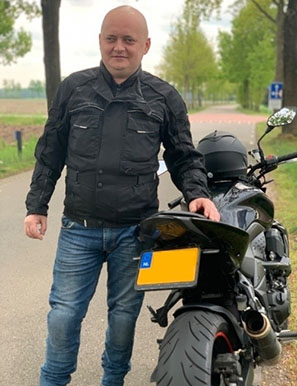Mobility during and after Covid19 Part 2: The Motor Bike
May 2020
By Rens Jonker, English adaptation by Eric van der Horst
In our April article about Covid19, one particular means of transport was missing; the motorbike. It has its role to play though. When motorbiking, social distancing is naturally in order, as there are no fellow passengers to take into account. Especially as the capacity of public transport is expected to remain lower in the post-Covid19 era, it should have more priority in mobility policies.
The motorbike is a very efficient individual means of transport for medium range distances. It can easily take on commutes simply too long for the (electric) bicycle. The motor cycles’ light engines are a lot more economical in consumption and cheaper to drive than cars. A consumption of 1:30 or more is no exception. European standards have pushed the emission of harmful substances from engines further down. Motorbikes take up far less road space than cars and regarding parking, one space for car parking can take four motorbikes.
The relative vulnerability of the motorcyclist is often cited as an argument against more motorcycles on the road. In The Netherlands the number of road fatalities involving motorcyclists has decreased significantly: from an average of 81.4 per year in the period 2000-2009 to an average of 49.2 per year in the period 2010-2019. These rates are negatively affected by the annual ‘spring’ effect. Recreational motorbiking has its seasonal boost and so do the accident rates. It is not just the riders themselves who have to get used on being on two wheels; the most common cause of these accidents, according to road safety institute SWOV, is the motorcycle being overlooked by a motorist.
Safety in numbers
The road safety concept “Safety in numbers” is often used in related to cycling. Its relevance has just been proved once again in Norway.
New research shows cyclists were better noticed in the months from June to September in comparison to the start of the Scandinavian cycling season in April. The same dynamics are at work in relation to motorcyclists. As the summer season progresses, motorists unconsciously take the presence of motorcyclists more into account.
The Dutch Statistics agency reported that in early 2020 almost 1.5 million people had a motorcycle license in the Netherlands, but that less than half of this number actually owns a motorbike (680,000 registered motorcycles). If a larger part of this group were to ride a motorbike regularly, riders would build more riding routine and other road users would become more accustomed to the presences of motorcycles. There is a large potential for this: statistics also show that around 800,000 licensed motorcyclists are currently likely to use cars or public transport for commuting.
Motorbike-friendly design
With more motorbike-friendly designs, the risks for motor cyclists being involved in an accident are actively reduced. Crash barriers especially could be made more functional for motor cyclists. More under-boards and reduction of ‘clutter’ between road and barriers (think of signs and light poles currently placed in front of the barrier instead of behind) are the main priority here. Strict compliance to rules when it comes to affixing road markings and taking motorcyclists into account when designing the road will create a better environment for motorbikes. Another point of attention is litter and dirt on roads. As motorcyclists are extra vulnerable, awareness schemes such as in Friesland province are welcome.
In addition, reduction of differences in speed between various road users also make roads safer for motor bikes. The newly introduced day-time speed limit on Dutch motorways has for example reduced the speed difference between A1 engines (with an engine capacity up to 125cc) and other traffic. This and the general reduction in the speed limit could lead to an increase in road safety for all road users – provided the speed limit is respected.
Welcoming drivers to become riders
By making it easier for drivers to obtain motorcycle licenses, using a motorbike rather than a car can become also more socially accepted. A number of Dutch lobbying organisations have put forward the idea to allow drivers to ride light motorcycles after a limited number of lessons. This is already possible in Germany (since early 2020), Belgium, the United Kingdom and other European countries. The Dutch minister for transport is currently considering this plan. However this works out, the more people have motorcycle licenses, the more sympathy and understanding of the motorbike’s position on the road, the more safe the motorcyclist will be.


